
OGN is a South Korean pay television channel that specialized in broadcasting video game-related content and esports matches, particularly StarCraft, Starcraft II, League of Legends, and Overwatch. OGN ran high level professional tournaments for 20 years; its premier competition included the Ongamenet Starleague (OSL), Proleague, League of Legends Champions Korea, and Overwatch APEX. It was previously a subsidiary of On-Media, the parent company of several other cable channels. After a corporate merger in 2010, it became a part of CJ ENM E&M Division. Most recently, League of Legends statistics website, OP.GG, which also sponsored LCK since 2022, has acquired OGN from CJ ENM following the shutdown of the linear TV network during the COVID-19 pandemic.

Jang Jae-ho is a South Korean professional gamer of the popular Blizzard real-time strategy games Warcraft III and StarCraft II. He is seen by many as the best Night Elf player in the world. Jang Jae-ho is a five time world champion and has won three televised national Korean WarCraft III Championships as well as four seasons of MBCGame's World War. He is particularly known for his excellent micromanagement and innovative strategies. He is often seen using strategies that later set the benchmark for many Night Elf players and was nicknamed the "5th Race" by Gametv.com. He has played and won more televised WarCraft III games than any other Warcraft III players. Jang Jae-ho is featured in the documentary film Beyond the Game. Moon transitioned to StarCraft II and was without a team for a while, before retiring from professional gaming in order to fulfill South Korean military service requirements. After completing his military service, Moon returned to Warcraft 3 and is currently active.

The real time strategy (RTS) computer game StarCraft had an active professional competition circuit, particularly in South Korea. The two major game channels in South Korea, Ongamenet and MBCGame, each ran a Starleague, viewed by millions of fans.

Yoan "ToD" Merlo is a French former professional player of the real-time strategy games Warcraft III and Starcraft II. In WarCraft III he played as the Human race and in StarCraft he played as Protoss. he was signed to the top esports team in the United Kingdom, Four-Kings, until 7 November 2007, when he decided not to renew his contract for unspecified reasons. He later explained in an interview that the dissatisfying results of the Four Kings team were the reason for his departure. After much speculation, Merlo unexpectedly joined the team Mousesports on 1 December 2007.

Lee Jae-dong, who plays simply under the name Jaedong, is a South Korean professional StarCraft: Brood War player and former StarCraft II player, playing most recently for team Evil Geniuses prior to his StarCraft II retirement. After retiring from StarCraft II, Jaedong returned to playing SC:BW. Announced as a full-time streamer on 12 November 2016, he made his return to the tournament scene a week later during the 2016 KT GiGA Legends Match lll. Using the Zerg race in both games, Lee is considered one of the most successful StarCraft players of all time, having won five OnGameNet Starleague (OSL) and MBCGame StarCraft League (MSL) tournaments, and earning over $600,000 in tournament prize money. His other nicknames include The Tyrant and The Legend Killer.
StarCraft II is a military science fiction video game created by Blizzard Entertainment as a sequel to the successful StarCraft video game released in 1998. Set in a fictional future, the game centers on a galactic struggle for dominance among the various fictional races of StarCraft.
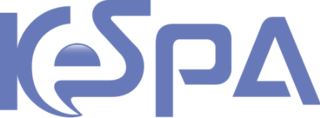
The Korea e-Sports Association (KeSPA) is a South Korean body established to manage esports in South Korea. It is a member of the Korean Olympic Committee and the International e-Sports Federation. As of June 2012, it was the managing body for 25 e-sports in the country, including Starcraft II: Legacy of the Void, League of Legends, Dota 2, and Counter-Strike: Global Offensive. KeSPA also hosts the KeSPA Cup, a yearly tournament event for some of their games.

Global StarCraft II League (GSL) is a StarCraft II: Legacy of the Void tournament held in South Korea from 2010 to the present. It has been hosted by afreecaTV since 2016; GOMeXp hosted it from 2010–2015. Blizzard Entertainment was involved in co-producing and co-funding it for much of its history, although their involvement reduced in later years. For the first two years of the tournament, it featured two leagues, Code S (major) and Code A (minor); afterward it ran as a single combined tournament.

The Global StarCraft II Team League (GSTL) was a StarCraft II tournament series hosted by GomTV and Blizzard Entertainment in South Korea. It ran from 2011 to 2013 as a team event parallel to the individual Global StarCraft II League, broadcast on Thursday and Friday, to not conflict with the GSL's Monday to Wednesday broadcast. Following competition with the KeSPA-run StarCraft II Proleague, which had fully transitioned to Starcraft II in 2013, the GSTL folded, having played its last grand finals event in November 2013.
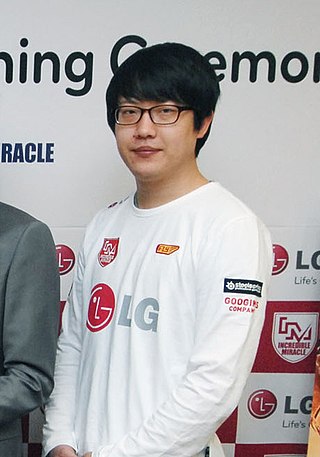
Lim Jae-Duk (Korean: 임재덕), known by the pseudonym of NesTea, is one of the most successful players of the real-time strategy game StarCraft II: Wings of Liberty. He has won $246,963 in tournament winnings over the course of his StarCraft 2 career, and has won three GOMTV Global Starcraft II League (GSL) tournaments, the third-most of any player, just behind teammate Jung "Mvp" Jong Hyun who has four titles as well as Maru who has recently won his seventh title.
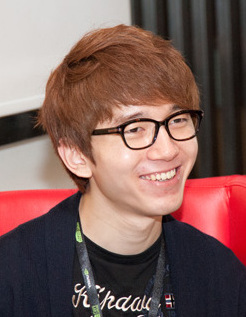
Park "Lyn" June (Korean: 박준) is a professional Starcraft II Terran player and former Warcraft III Orc player from South Korea. Lyn was a successful Warcraft III player before transitioning to Starcraft II. He is the only player to have won almost all of the premier tournaments, including the World Cyber Games, Electronic Sports World Cup, BlizzCon and Intel Extreme Masters. The only two premier tournaments which he has never won are the World e-Sports Games and International E-Sports Festival, instead placing second in the World e-Sports Games in 2008 and 2010, and in the International E-Sports Festival in 2007. The total prize money Lyn has won playing Warcraft 3 is behind only Jang "moon" Jae-ho.
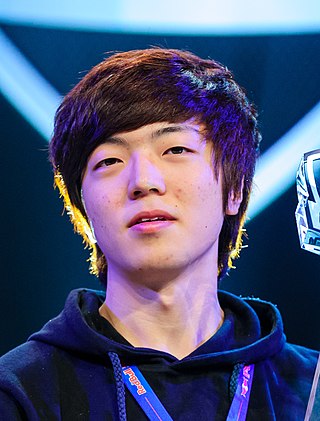
Lee Seung-Hyun, better known as Life, is a South Korean former professional StarCraft II player. He began his professional career in 2011 with Team Zenex, which later merged with StarTale. He subsequently represented teams such as KT Rolster and briefly, Afreeca Freecs. Throughout his career, Life distinguished himself as one of the most accomplished StarCraft II players in the history of the game. He secured numerous premier tournament victories, including a World Championship Series title in 2014, two Global StarCraft II League (GSL) titles, a GSL Blizzard Cup title, two Major League Gaming events, two DreamHack tournaments, and one Intel Extreme Masters competition.
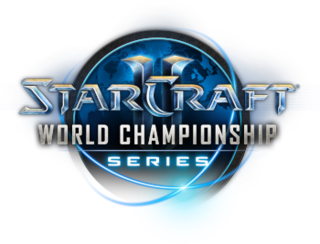
The StarCraft II World Championship Series (WCS) was a StarCraft II professional tournament series organized and sanctioned by Blizzard Entertainment that ran from 2012 to 2019. For all but its first year of operation, it was the highest tier of professional StarCraft II competition. Its longest-running iteration featured two regions, World Championship Series Korea and World Championship Series Circuit, with World Championship Series Global events featuring players from both regions. Grand finals were held annually at BlizzCon in Anaheim, California, except for the first year of competition, when the finals were held in Shanghai, China. WCS Circuit events were streamed on Twitch while WCS Korea events were available on Twitch, YouTube, and afreecaTV.
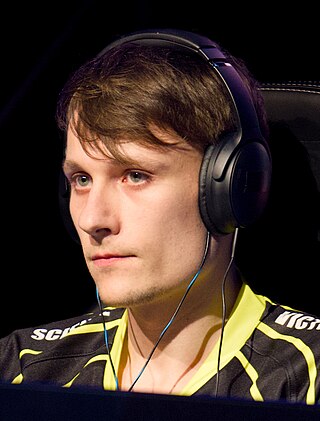
Joona Sotala, better known as Serral, is a Finnish professional StarCraft II player using the race Zerg. In 2018, Serral became the first non-Korean player to win the StarCraft II World Championship Series (WCS). He won every major non-Korean tournament in 2018, the 2018 Global StarCraft II League (GSL) vs. the World event and, ultimately, the 2018 WCS Global Finals. In 2022, he won the Intel Extreme Masters Katowice, and with the updated championship format he won the world championship of StarCraft II for the second time.
The 2018 StarCraft II World Championship Series (WCS) is the 2018 edition of the StarCraft II World Championship Series, the top esports tournament circuit for StarCraft II. Featuring the top eight players from each WCS region, World Championship Series Korea and the World Championship Series Circuit, the Global Finals received greater coverage than most prior events when Finnish professional player Joona "Serral" Sotala became the first non-Korean world champion in the StarCraft series.
The 2017 StarCraft II World Championship Series (WCS) is the 2017 edition of the StarCraft II World Championship Series, the highest level of esports competition for StarCraft II. The tournament series' Global Finals were won by South Korean professional player Lee "Rogue" Byung Ryul.
The 2016 StarCraft II World Championship Series (WCS) is the 2016 edition of the StarCraft II World Championship Series, the highest level of esports competition for StarCraft II. The tournament series' Global Finals were won by South Korean professional player Byun "ByuN" Hyun Woo.
The 2014 StarCraft II World Championship Series (WCS) is the 2014 edition of the StarCraft II World Championship Series, the highest level of esports competition for StarCraft II. The tournament series' Global Finals were won by South Korean professional player Lee "Life" Seung Hyun.
The 2013 StarCraft II World Championship Series (WCS) is the 2013 edition of the StarCraft II World Championship Series, the highest level of esports competition for StarCraft II. The tournament series' Global Finals were won by South Korean professional player Kim "sOs" Yoo Jin.
The 2019 StarCraft II World Championship Series (WCS) is the 2019 edition of the StarCraft II World Championship Series, the top esports tournament circuit for StarCraft II. The tournament series' Global Finals were won by South Korean professional player Park "Dark" Ryung Woo.












